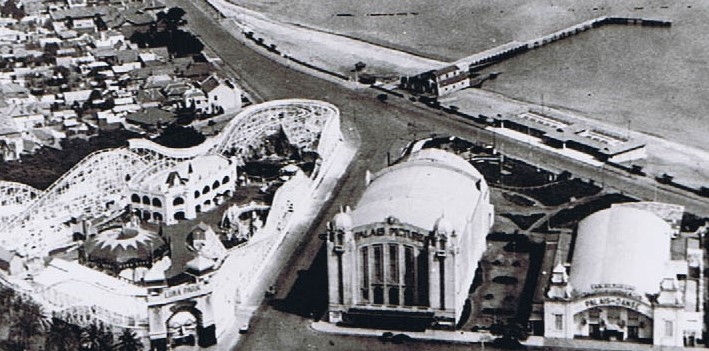Frederick Brooke was a well-known St Kilda fisherman and boatman.
Sometimes he was called Brooks, sometimes Brookes, occasionally Brook but in his Supreme Court probate and administration file his name is Frederick Brooke, an Englishman who married Alice Davies in Melbourne in 1866. In the early 1870s St Kilda Rate Books, Brooke, occupation boatman, was living in Havelock Street St Kilda renting a house from Timothy Kelly. By 1875 he was the owner-occupier of a four roomed wooden house on Marine Parade. His occupation was now ‘fisherman’. He must have been handy, as, by the following year his home had grown to five rooms. The site is now occupied by the 1920s-era ‘Brookleigh’ Flats at 5 Marine Parade.
Fishing at St Kilda
In 1873 Brooke was fined five shillings for keeping his boat on the beach between the Main Drain and the Baths, the same year two teenage boys were prosecuted for stealing Brooke’s fishing nets from the beach. Both boys got short prison sentences. In a separate incident, in March 1873 Charles Beasley was brought to court from the Pentridge stockade, charged with stealing Frederick Brooke’s fishing net valued at £2-10 shillings, last seen by Brooke in 1871 when he laid it out to dry on St Kilda beach. Brooke subsequently spotted portions of his net at two pawnbrokers’ shops – Mr Moss’ in Chapel Street and Mr Levy’s in High Street. The court found the evidence inconclusive and dismissed the case.
The Boatshed
In March 1884 Frederick Brooke applied to the Office of Lands and Survey for a licence to occupy part of St Kilda’s South Beach for boat repairing purposes. After much toing-and-froing between the Council, the Public Works Committee and the Lands Department, in August the Council wrote to the Department of Lands advising that it had no objection to Brooke being issued with a licence to construct his boat repairing and boatshed facilities on St Kilda beach.
The trip to Geelong
About 10am on the morning of Wednesday 10 December 1884 at St Kilda pier, Frederick Brooke boarded the 20 foot yacht ‘Rover’ with the yacht’s owner, Christopher Trewhella who wanted the boatman’s assistance sailing to Geelong so that he and his yacht could participate in the Geelong Regatta scheduled for Friday 12 December. Even before the pair took off, witnesses described the weather as turbulent.
Newspaper reports described the Cornish-born Trewhella as a man of means and his occupation in the St Kilda rate books was ‘gentleman’. He and his brothers made small fortunes mining at Blackwood, enabling Christopher Trewhella to purchase land on Beaconsfield Parade where he built a family home for his wife Alicia Flemming who he married in 1882 (now the 1920s San Remo Flats at 354 Beaconsfield Parade) all the while indulging his passion for yachting.
The Storm
Brooke and Trewhella hadn’t sailed very far before they encountered difficulties. Richard Banner, Master of the yacht ‘Janet’ owned by Sir William Clarke’ was also sailing to Geelong that day to participate in the Regatta. Banner later testified that he and his crew observed the yacht ‘Rover’ off Point Cook with two men aboard baling but as they didn’t appear to be in distress, the ‘Janet’ continued to Geelong. According to the Geelong Harbour Master, Abraham Pleace who was patrolling the harbour near Point Wilson on 10 December, conditions on Port Phillip Bay between 12 midday and 3 o’clock were so dangerous with westerly squalls and heavy seas, he ordered his crew to return to Geelong. Trewhella and Brooke were soon reported missing presumed drowned.
The Search
On 14 December Abraham Pleace set sail with five men and the local police constable to raise the missing yacht which had been found about five cables (approximately one kilometre) off Point Wilson. The yacht was standing upright in fifteen feet of water with six to eight feet of mast visible above the waterline. Despite the valiant efforts of Pleace and his crew they were unable to lift the yacht due to heavy seas. They recovered some equipment and personal items but found no bodies. On 24 December, Charles Hooper a Geelong fisherman was employed by Benjamin Trewhella , Christopher’s brother, to recover the yacht. This time the rescue was successful and the yacht was towed to Geelong. Personal items were found which Alice Brooke later identified as belonging to her husband.
The Aftermath
Despite extensive searches in the surrounding waters and along the coastline, no bodies were ever found although two local boys did find a skull on the beach between Little River and Point Wilson.
On 9 January 1885 Mrs Alice Brooke placed an advertisement in the Geelong Advertiser offering a £5 reward to anyone who found the remains or belongings of Frederick Brooke that would prove him to be dead or alive. Benjamin Trewhella had, on 6 January, placed a similar advertisement in The Age, this time offering a £10 reward.
Unfortunately Frederick Brooke left no will so Letters of Administration were granted to his widow Alice on 19 March 1885. They had five children – George Frederick, William Arthur, Alice Jane, Eliza Ida, Edith and Edward Charles – all legally minor children at the time of their father’s death. His estate included a five roomed lathe, plaster and weatherboard house with an iron roof on Marine Parade and a boathouse with boats and nets on the beach.
The family lived on in the area for many years with his sons George Frederick and William Arthur building the jetty in 1911 which was demolished in 2015.
In her affidavit on her husband’s probate file Alice Brooke rather poignantly recorded that on 10 December 1884: “I watched the said yacht ‘Rover’ proceeding out to sea until she was out of sight”. She died in 1930 aged 88.
Compiled by: Liz Kelly - March 2021
Sources:
Public Records of Victoria – Wills and Probate
Ancestry.com.au – Victoria, Australia, Rate Books 1855-1963
https://trove.nla.gov.au/newspaper
https://www.bdm.vic.gov.au/research-and-family-history




